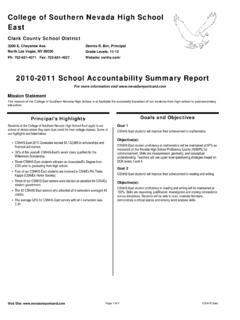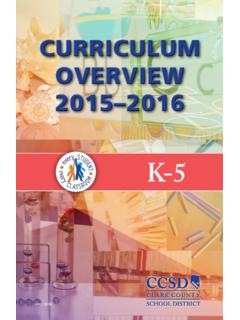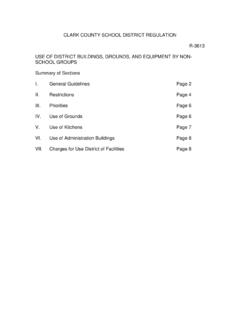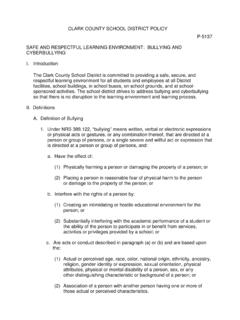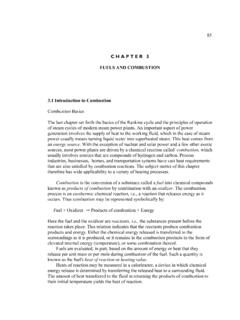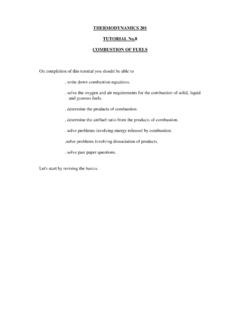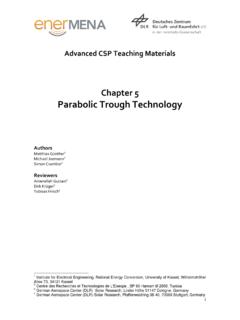Transcription of ROOT CAUSE ANALYSIS - Clark County School District
1 root CAUSE ANALYSIS Access School Improvement tools on the website by going to: > Directory > Assessment, Accountability, Research, and School Improvement > on the side click on School Improvement > Templates and Resources >2012 CCSD School Improvement Template. Assessment, Accountability, Research, and School Improvement1 of 31 Contents Learning Outcomes .. 3 3 School Improvement Planning Process Map .. 4 Data Trends/ Checklist .. 5 Developing Trend Statements (Example and Blank Template) .. 6-7 Quality Criteria .. 8-9 root CAUSE ANALYSIS : Background .. 10-13 Levels of root CAUSE .. 14 root CAUSE : Identification Circle Map Example .. 15 When is a CAUSE a root CAUSE ? .. 16 Criteria for Narrowing Explanations .. 17 root CAUSE ANALYSIS .. 18 Why .. Because Activity .. 19 Validate root causes .. 20-21 Terminology .. 22-24 root CAUSE ANALYSIS : Toolbox .. 25-31 Assessment, Accountability, Research, and School Improvement2 of 31 Learning Outcomes Identify concerns from performance trends Create Circle Map from site data (listing all possible explanations) Categorize/Sort causes based on the four levels of root CAUSE ANALYSIS Questions/Clarify Is this really a CAUSE ?
2 Narrow explanations Because Process Validation of root causes Inquiry and SIP Template Assessment, Accountability, Research, and School Improvement3 of 31 School Improvement Planning Process Map Assessment, Accountability, Research, and School Improvement4 of 31 Data Trends/Checklist Review written trends: Content area from School Performance Framework (SPF) and data support from Green & Whites, 3 Year Trend Report, or site-based data Identify measures/metrics Which students (grade and disaggregated group) Direction of trend (increasing, decreasing, or stable) Amount of increase, decrease, etc. Time period (at least 3 years) Performance indicator: Academic Growth & Academic Achievement Completed Data Trends: Use Quality Criteria to evaluate performance trends (pg. 8) Indicate that your team is ready for a facilitator to provide feedback about your positive and negative performance trends Data Trends in Progress: Finalize Data ANALYSIS Use Performance Data Inventory (pg.)
3 6-7) to write positive/negative trend statements Identify 2-4 priority concerns Assessment, Accountability, Research, and School Improvement5 of 31 Assessment, Accountability, Research, and School Improvement6 of 31 Assessment, Accountability, Research, and School Improvement7 of 31 QUALITY CRITERIA Plan Element (definition) Criteria Performance Trends Description of trends for every performance indicator, identified based on ANALYSIS of three years of data. Makes explicit to which performance indicator/sub-indicator the trend applies, and the direction of the trend ( , strengths and challenges). Specifies performance indicator areas where the School failed to meet District (academic achievement, academic growth, academic growth gaps, post-secondary/workforce readiness), state/federal (AYP targets), or School performance expectations. Includes ANALYSIS of data at a more detailed level than that presented in the SPF report, for example, patterns over time: o for cohorts of students (3rd grade in one year, 4th grade in the next year, 5th grade in the third year); o within a grade level (per content area, disaggregated group); o within a disaggregated group of students; and/or o within a content strand ( number sense in mathematics).
4 Includes ANALYSIS of relevant local performance data. To the degree that data are available, includes ANALYSIS of the performance of all students in the School ( , pre-K-2), and includes performance in subjects not tested by the state. Priority Concerns (performance challenges) Specific statements about the School s performance challenges (not statements about budgeting, staffing, curriculum, instruction, etc.), with at least one priority identified for each performance indicator where the School did not meet federal, state and/or local expectations. Identifies at least one priority concern (performance challenge) for every indicator (achievement, growth, growth gaps, post- secondary/workforce readiness) for which minimum expectations were not at least met. Specifies priority disaggregated groups. Required for Title I AYP targets or safe-harbor targets; recommended for all others. Identifies priority performance challenges based on ANALYSIS of performance trends. Specifies needs at a more detailed level than that presented in the SPF report, for example: o for cohorts of students (3rd grade in one year, 4th grade in the next year, 5th grade in the third year); o within a grade level over time ( consistently not meeting expectations in 4th grade mathematics for three years); o within a disaggregated group of students; and/or o within a content strand ( number sense in mathematics).
5 Priority concerns describe the strategic focus for the School considering every sub-indicator for which the School did not meet expectations. Priority concerns do not need to be identified for every sub-indicator ( , math achievement, ELL student growth in reading) for which the School did not meet expectations. Assessment, Accountability, Research, and School Improvement8 of 31 Plan Element (definition) Criteria root causes Statements describing the deepest underlying CAUSE , or causes , of performance challenges, that, if dissolved, would result in elimination, or substantial reduction, of the performance challenge(s). Identifies one root CAUSE for each priority performance concern (the same root CAUSE could apply to multiple priority performance challenges, and should be listed next to each priority performance challenge to which it applies). Specifies causes the School can control ( , the School does not provide additional support/interventions for students performing at the unsatisfactory level) rather than describing characteristics of students ( , race, poverty, student motivation).
6 Reflects ANALYSIS of multiple types of data (in addition to performance data and including local data sources) in the identification of root causes . For schools with performance that does not meet expectations on a large number, or all of the performance indicators/sub-indicators, explicitly considers broad, systemic root causes . Priority Concern Examples For the past three years, English language learners (making up 60% of the student population) have had median growth percentiles below 30 in both content areas. The percent of fifth grade students scoring proficient or better in mathematics has declined from 45% three years ago, to 38% two years ago, to 33% in the most recent School year. For the past three years, the median growth percentiles in grades 4 through 6 in reading have been 39 or below, which is less than the minimum District expectation of 46. Apply Quality Criteria Use the Quality Criteria for Performance Trends and Priority Concerns (Page 8-9). Consider: How are the trends and priority concerns similar and/or different from that reflected in quality criteria?
7 How could these sections be improved upon? Assessment, Accountability, Research, and School Improvement9 of 31 root CAUSE ANALYSIS : Background Excerpted from: Preuss, (2003). School Leader s Guide to root CAUSE ANALYSIS : Using Data to dissolve Problems. Larchmont, NY: Eye on Education. What is root CAUSE ? Rather than assume knowledge of what a root CAUSE is, let s first look at several definitions: From the Savannah River Project (a nuclear power station): root CAUSE is the most basic CAUSE that can reasonably be identified, that we have control to fix, and for which effective recommendations for prevention can be implemented. From Medical Risk Management Associates: root causes are the underlying CAUSE of adverse out comes. From the Joint Commission on Accreditation of Healthcare Organizations: root causes are the basic or casual factors that under lie variation in performance, including the occurrence or possible occurrence of a sentinel (major) event. From Business Solutions The Positive Way: root causes are the basic CAUSE or causes of the problem or symptoms.
8 From Total Quality Schools, by Joseph C. Fields: A root CAUSE is the most basic reason the problem occurs. Other organizations differentiate between contributory or proximate causes and root causes . Often, the most immediate or obvious CAUSE is mistakenly identified as the root CAUSE when, instead, it is simply the most proximate contributory CAUSE , which itself has much deeper roots. Example: Often, blame is first centered on an individual. Although an individual may have indeed committed an error that resulted in a problem, a deeper CAUSE may be found in areas such as: training of the individual, scheduling of the individual, assignment of duties, clarification of duties, supervision, work environment, or anyone of a host of other issues. Most people involved in root CAUSE ANALYSIS understand that the vast majority of root causes are system-based rather than individual-based. For purposes of this guide, the following definition suffices: root CAUSE the deepest underlying CAUSE , or causes , of positive or negative symptoms within any process that, if dissolved, would result in elimination, or substantial reduction, of the symptom.
9 Assessment, Accountability, Research, and School Improvement10 of 31 Let s look at this definition again, this time highlighting and commenting on its various essential components: root CAUSE the deepest underlying CAUSE , or causes , of positive or negative symptoms within any process that, if dissolved, would result in elimination, or substantial reduction, of the symptom. Deepest this means that we really have to dig deep to find most roots. They usually are not the most immediate, obvious, or proximate causes . Often, they are three, four, or five layers down into the system. Example: A high School has a high number of local (general) diploma graduates. However, the state is requiring that 100 percent of graduates have academic diplomas within a few years. Taking a detailed look at the local diploma recipients, it is found that fully two-thirds either had exceeded academic diploma requirements or were close to them. Upon further investigation, it is found that guidance counselors, and even the high School principal, communicate to parents and students that the academic diploma is not necessary for college acceptance or future success.
10 Emphasis is placed on SAT scores instead. In discussions with the counselors and principal, it is found that the system has never placed emphasis on academic diplomas, and, in fact, the School s personnel felt they were doing their duty in accordance with what they believed the School system and the community wanted. The District (system) had not communicated this change in goals to its staff. A few people take issue with the use of the term root CAUSE and prefer instead the concept of causal ANALYSIS . Their reasoning is that the concept of root CAUSE came out of an industrial mechanical environment that is not suited to education and that there are usually multiple causes rather than a single root . Obviously, I have chosen to stick with the concept of root CAUSE . I really do not care where it was first used because I believe the metaphor works in any context. I especially like the concept of root because it implies that we must dig deeply to find CAUSE . To me, the term causal ANALYSIS facilitates the easy, knee-jerk response of I know the CAUSE here it is, rather than demanding the deep search that is typically required.




